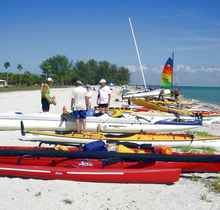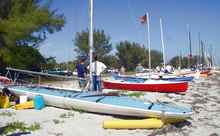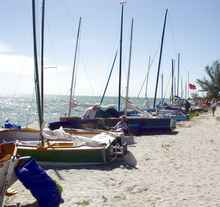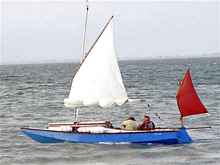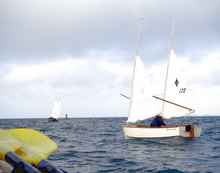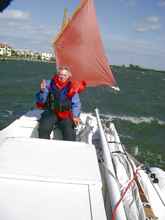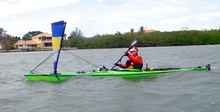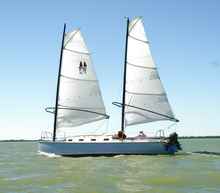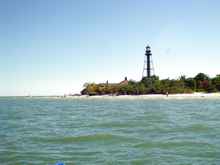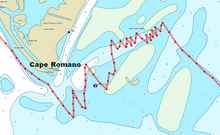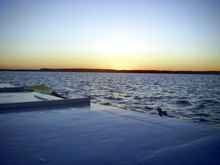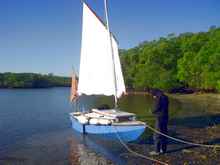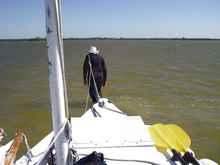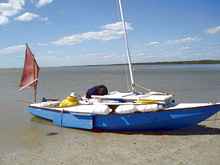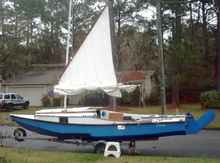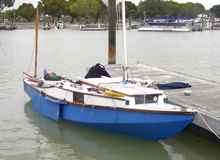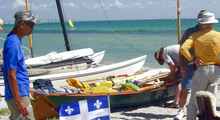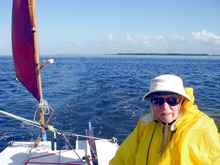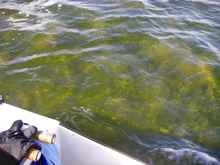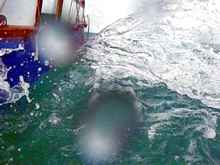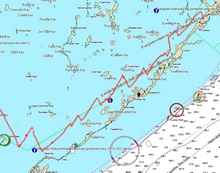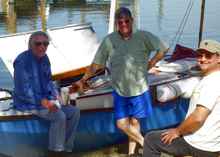
 Custom Search
|
|
| sails |
| plans |
| epoxy |
| rope/line |
| hardware |
| canoe/Kayak |
| sailmaking |
| materials |
| models |
| media |
| tools |
| gear |
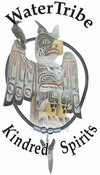 |
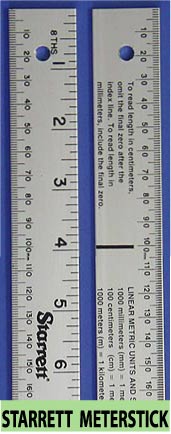 |
| join |
| home |
| indexes |
| classifieds |
| calendar |
| archives |
| about |
| links |
| Join Duckworks Get free newsletter Comment on articles CLICK HERE |
|
|
| EC 2012 |
by Gary and Helen Blankenship - Tallahassee, Florida - USA |
Thump. Splash. Splat. Thump. Splash. Splat. Those sounds are etched in my memory, the dominant audible imprint from the 2012 Everglades Challenge. The thump was from Oaracle's flat bottom pounding down on waves as we beat to windward in strong winds. The splash was the resulting spray that was thrown up. The splat was that spray all too frequently finding me and John Wright, who accompanied me on this year's challenge, in the cockpit. Often we took that spray full in the face. (One creative stream came off the cabin top and found a tiny opening at the neck of John's foul weather gear.) There was some exhilarating reaching and running as well, but sometimes it seemed those were mere interludes to get to the next extended bout of thump, splash, and splat. After the finish, I calculated we had spent a total of 85 to 86 hours under sail completing the challenge (the GPS registered a total of 317 nautical miles while a straight line course is probably 260 to 270 nautical miles). Roughly 30 of those hours were spent beating, all but about four or five of them with the sail double reefed in winds that wavered on either side of 20 knots. Some of that sailing was in protected waters without choppy seas, but most was open enough to produce plentiful spray over Oaracle and her wet crew. It was a tough race. It was the seventh time Oaracle and I have been in an EC, once solo and the rest with crew, and the fifth time we reached (maybe "staggered to" is a better description this year) the finish. This was the toughest of the seven and, with the possible exception of 2007, featured the strongest winds. But in 2007, the winds were mostly behind us and we only did a little beating. For those unfamiliar with the Everglades Challenge, full details and the rules are available at www.watertribe.org. In brief, it is an adventure race for kayaks, canoes and small sailboats. It begins with a beach launch at Ft. Desoto Park on the northern side of the mouth of Tampa Bay and ends in Key Largo. There are three mandatory checkpoints, variously involving a low bridge (the mast must come down for sailboats), narrow twisty channels, and tricky tides. There are six classes. Three are for canoes and kayaks and are divvied up according to whether they carry sail and if so what kind of sails. The fourth class is for monohull sailboats (like Oaracle) and the fifth is for multihull sailboats. The sixth is an exhibition class, which this year had a six-person outrigger canoe. Aside from the Everglades Challenge, there is also the 67-mile Ultra Marathon, which ends at the first EC checkpoint. This year also featured the 1,200-mile Ultimate Florida Challenge, complete with a 40-mile portage (see the WaterTribe site for full details on that). As noted above, John Wright, aka St. John of Bastrop, had consented to come along for this year's adventure. He had entered two previous ECs but had bad luck in both and hadn't finished. He was determined to change that this year. (A quirk of WaterTribe events is participants must pick nicknames. John is Karank, after a Texas Indian tribe. I'm Lugnut.) We got to Ft. Desoto on Thursday and made sure to get a good night's sleep. On Friday, we sailed Oaracle from the park's launching ramps to the starting beach so John could get a feel for the boat. Robert Terry from Bradenton, a future hopeful EC participant who would store my pickup and trailer for us during the race, also came along. It was John's (and Robert's) first time on Oaracle and the first time I had sailed to the start rather than taking the boat to the beach on a trailer. There were light winds at the ramp that freshened as we sailed along and provided an exhilarating broad reach by the end of the sail. We beached and with some help hauled the boat above the high water mark.
The weather forecast for the start on Saturday, March 3, was not encouraging. It promised south winds of 20 knots all day and through the evening. After midnight, a strong cold front was predicted to come through, with breezes shifting first to the west and then the north. Strong thunder and lightning storms were projected, followed by winds of 20 to 25 with gusts to (gulp) 45 knots. At least it would be warm Saturday, with a high in the low 80s, the warmest EC start I could remember.
Saturday brought mostly clear skies with the predicted strong southerly winds. Watching a flag in a neighboring boat's rigging flap straight out to the north, John and I agreed to start with a double reef in the main along with the tiny mizzen. We also decided to stay in the Intracoastal Waterway (ICW), rather than try to beat down the open Gulf in seas that were predicted to be as high as seven feet. The ICW would have its own problems but we wouldn't be trying to drive a boat that weighs 350 pounds empty into big seas in the Gulf. (A few boats managed to go outside and a couple started to go outside, decided it was too rough, and came back to the ICW.) Seven a. m. brought the start and the kayaks sprayed out from the beach, like a flock of birds taking flight, accompanied by a few of the sailboats. John and I waited for a Hobie Adventure Island close beside us to launch, and then trundled Oaracle down to the water with a fender and high density pool noodles under the hull. By 7:15 we were underway.
Initial progress was good but for a few minutes we wondered if we needed only one reef. But the wind soon picked up and ended any further consideration that day about adding sail. The first of the spray soon began flying over Oaracle's bow as Tampa Bay provided its expected choppy waters, with waves reaching about three feet and whitecaps everywhere. About halfway across the Bay, we had our only gear failure. The cam cleat holding the main halyard let go, and the billowing sail came down with a run. Meade Gougeon (Yellowthing), of WEST epoxy fame, was nearby and came over in his gorgeous sailing canoe and stood by in case we needed help. But the sail was soon back up and tied off to a spare traditional cleat. From the launching beach across Tampa Bay to the start of the ICW is 6.1 nautical miles; in favorable winds Oaracle has made it in just over an hour. With strong contrary breezes, it took three hours and two long tacks to get across the bay. Early on, we were in company with MisterMoon (John Bell) in his Core Sound 17 who was doing the Ultra Marathon. Slightly ahead were Ridgerunner and Greybeard (Doug Cameron and Michael Collins) in a Core Sound 20. Both gradually edged ahead of us. We did hit the start of the ICW almost dead on, more due to luck than any great navigational skill of mine. Then it was short tacking down the ICW, avoiding the mostly visible shoals. A bit over an hour later, we fetched up at the first drawbridge.
And the first real problem. Oaracle's rig was short enough to fit under the bridge without requiring it to open. But the wind was dead ahead there was an adverse current under the bridge as well. John, well familiar with the inland waterways of Texas, explained that when a strong wind blows up or down such a waterway, it creates its own current and overrides tidal influences. That was what we faced. John and I took turns trying to row through, with equal outcomes - we would get halfway through and no further. It was like hitting a giant invisible rubber band that would stretch only so far. Ridgerunner and GreyBeard and MisterMoon in their respective Core Sounds had preceded us to the bridge and had the same results. A couple other Class 4 boats arrived to join the general milling about. John suggested heading toward the eastern shore to see if we could take down the mast and walk the boat under the bridge in hopefully shallow water there. I was reluctant, having done that in the 2004 EC under a different bridge. That turned out to be a nightmare of oyster encrusted rocks. But then we noticed GreyBeard and Ridgerunner were trying the same thing, and had found shallow water if nothing else. We followed and in fact found it easy to beach, drop the rig, walk it around, and get the mast back up. Other class 3 and 4 boats followed us. John walked Oaracle about 50 yards upwind to ensure the wind and current didn't carry us into the bridge and we were off - heading for the next bridge about two miles up. Total time to clear the first bridge - two hours! A powerboater seeing Ridgerunner and GreyBeard's maneuver at the first bridge pulled up to advise them it would work at the next bridge, but on the west side. They headed that way and we, along with MisterMoon, followed. They waded their boats under the bridge while we were able to row. Tied up to some marina pilings on the other side (there was no beach here), we raised rigs again and sailed away. This was tricky, as we were only 40 to 50 feet from the bridge with both an adverse wind and current. It was now approaching 3:30 p. m. From here, the ICW headed to the west side of the bay, including behind a couple islands. That gave us a break from the waves without interfering too much with the wind. The two Core Sounds and Oaracle stayed in company as we went by Longboat Pass. On one tack, John and I caught a favorable lift and slid by the Core Sound 20 and headed back into the main body of Sarasota Bay as the afternoon aged. Soon the waves picked back up but at least we were able to stay on one tack heading down the bay. In the choppy water, both Core Sounds soon slid by us. It was another long, wet slog and the sun disappeared under the horizon long before we reached the end of the bay. A serious fright came when a powerboat running without running lights sped by about 50 feet away - fortunately Oaracle's lights were on. At the base of the bay, a few tacks brought us to the first Sarasota bridge - and some good news. It was on single columns which were far enough apart that there was no trouble tacking through. The narrower and shallower water on the south side was calmer and we short-tacked to the Siesta Key bridge, which was like the first two bridges of the day and could not be sailed through. Neither shore appeared amendable to walking through with the mast down. John and I cruised along the span, checking it out and plotting a strategy. The decision was to try to go through two or three columns over from the main channel which would cut the rowing distance since we wouldn't have to deal with the wooden fender abutments at the main channel, and the current might be a bit less. Still scouting and approaching the western shore (which appeared to me to be a high, unfriendly bulkhead in the dark) we heard some people on the bulkhead shouting at us. The only word I could make out was "bulkhead." and since they were wearing headlamps, I figured they were likely fellow WaterTribers warning us about the bulkhead. In fact, it was Ridgerunner, GreyBeard, and MisterMoon, who had tied up in the lee of the bulkhead to await the wind shift from the approaching front before moving their boats to the other side of the bridge. With John at the helm, we tacked away from the bulkhead and approached the bridge at an angle. Three spans west from the channel he turned into the wind and I began rowing. We plodded through the opening against a reduced current, emerging gratefully on the other side. It was now past 10 p. m. and this was as far as I realistically hoped to get against the strong southerly wind. The ICW narrows here, flanked by shallows and spoil islands. Too much to pick through in the dark. So we sailed a bit south of the bridge and then chose a spoil island on the east side with enough water to anchor behind. There was a gentle, soothing rocking from southerly wavelets that managed to reach us, but the boat would be completely protected when the winds shifted to the west and then north. It had been a long day. We had been under sail for just over 15 hours. According to the GPS, Oaracle had sailed about 40 nautical miles but on a straight line had come 21 nautical miles. (The meandering ICW adds a few miles to the distance and of course we had spent time and distance sailing back and forth at two of the bridges.) We still had 31 (again straight line) miles to go. I called my wife Helen to let her know we had stopped for the night and then phoned the race manager to leave a message that we had stopped, but planned to continue in the morning and would not make the noon Sunday deadline for Checkpoint 1. I wasn't worried about this, being reasonably certain most of the fleet was not going to make the deadline given the rough headwinds of the first day. (In fact, of all the Class 4 boats in the EC and UM, only Wizard (Matt Layden) in the UM made the noon Sunday deadline. In an 8-foot boat! That's why we call him Wizard.) It was a fitful night. I was woken once by high winds blasting through the rigging, and another time when the small waves began hitting us from abeam - the wind had shifted west and the small southerly waves hadn't died away yet. There was some lightning, but none too close, and a couple splatters of rain. Daylight came with the predicted strong northerly winds. I'm a poor wind estimator but they seemed to be about 30. The weather radio spoke of gusts in the 30s and 40s. The boat was in flat, protected water, but the ICW a short ways off had whitecaps although the waves seemed small. John and I had a quick breakfast and decided to try sailing with only the mizzen, which is all of about 13 square feet. It would be a downwind run in the strong northerlies. There were plenty of spoil islands to duck behind if problems arose. Shortly after 9 a. m., with feelings of apprehension at least on my part, we were off. But it turned out to be no problem. The strong northerlies had reversed the previous day's adverse current into a favorable one. The small mizzen billowed out and we averaged 5 knots or a bit more, and occasionally passed 6, all in perfect comfort. Best of all, with the following winds and smaller waves in the protected water, there was no spray. After a while, we decided to take down the mainmast. It might have been possible to set the triple-reef main and really add wings to our downwind flight. But there were three drawbridges between us and Venice, all lower than the mainmast (but taller than the mizzen). If one of them was late in opening (we found out later one was broken), we would find ourselves trying to maneuver in constricted waters with the wind and current pushing us toward the bridge. Our choice was for comfort and safety.
It was a fun run, sliding through bridges, looking at the passing condos and fancy waterfront homes. We only saw a couple powerboats all day out in the wild winds. At one point, Hammerstroke (Will Schaet) slid by in his Class 1 kayak with its downwind only sail, using his paddle to brace in the following chop. He apparently stopped for a break just ahead of us, because a few minutes later, he passed us for the second time. Got better pictures that time.
By noon, we were at the Venice Inlet. Looking out the inlet was an impressive sight. First a wave broke over the southern breakwater, then one broke over the northern breakwater (in calmer weather, people fish from these rocky outcroppings, but not today). Then a wave broke all across the mouth of the inlet. We shuddered at the thought of anyone out on the open Gulf as we turned inland and ran east for the start of the canal that runs south from Venice. Halfway to the start of the canal a brown snout broke the surface about 20 feet of the starboard side, followed by a broad back and then a powerful fluke that left a giant, circular boil of water as it propelled the manatee below the surface. John and I were thrilled at our close if momentary encounter as the gentle mammal headed astern. The manatee went his way and we continued, passing under two drawbridges and turned south between the banks of the Venice Canal. There still seemed to be a favorable current, although a bit less than before. Our speed dropped slightly but we still waited before first putting up the mainmast and then the triple-reefed main. I was a bit worried Oaracle might be overpowered when entering the gradually widening Lemon Bay. But the boat handled it like a champ. The Spot satellite messenger, required for all EC competitors and which ticked off our position every 10 minutes, told the story. The speed never dropped below about 6.1 knots and frequently averaged of 6.6 to 6.7 knots (which meant much of the time the boat was exceeding 7 knots). Even with the favorable current, that was flying for Oaracle, which must have been at or a bit over her theoretical hull speed. The bay never widened enough to allow enough of a chop to cause discomfort and it was simply great, fast sailing. A hour and a half later we rollicked by Stump Pass and in another hour we slid through the narrow channel at the end of Lemon Bay, and were at the swing bridge in Gasparilla Sound. After a 20 minute wait for the next scheduled bridge opening, Oaracle squirted through and past the abandoned railroad bridge to the south. We made our turn into the side channel and headed towards shore and CP 1. After lowering the main and mast, we then rowed a short distance up a creek and under a bridge to the checkpoint. Oaracle's tired and happy crew arrived at 5:15 p. m. We decided to spend the night and leave in the morning. I had slept only fitfully the night before and wanted to get a good night's sleep before leaving. Plus, the wind was still high. A quick turnaround would mean tackling the usually rough Charlotte Harbor in dim light or the dark, and possibly running through Pine Island Sound and into the open Gulf before the winds and seas died down. At least somewhat lighter and more northeasterly winds were predicted for the next day. (I don't recall hearing any forecast for the entire EC what wasn't replete with small craft advisories.) That night as we slept, GreyBeard and Ridgerunner came in and left and MisterMoon finished his Ultra Marathon, the third and last of the 12 boats entered in that event to complete the course. PlumbCrazy In the morning I wondered if we had waited too long as the wind seemed calm at the checkpoint. We left at 7:30, John rowed us down the creek and the mainmast and sails went up. A light wind enabled us to sail out the side channel, and then a steady breeze arrived as we turned south in the ICW. It increased, producing 4 to 5-plus knots under full sail - the first time there weren't at least two reefs in the main. It was great sailing until Charlotte Harbor and the mouth of the Boca Grande Inlet, an area that seems to delight in playing nautical tricks on me. At least I rarely have a placid trip through here. And certainly didn't this time. A sudden increase in the wind to over 15 coincided with a strong contrary incoming tide. A very steep, very short 2-3 foot chop built almost instantly, hitting Oaracle on the port quarter and trying to slew the boat into a broach. I wanted to tie in the first reef but the short seas were so rough that it seemed imprudent to slow the boat for that, so we eased the sail forward of the mast to lessen the impact of the gusts. Even bucking the tide, the Spot showed Oaracle was averaging over 5.5 knots. After a few minutes of the wild ride, a gust hit and heeled Oaracle just as a wave lifted and slapped at the stern, and she pitched sharply to starboard. I released the sheet and rounded up with the tiller and both John and I lunged as high as we could get on the port side. After a scary moment, the boat came back upright and resumed her charge past the inlet. "We didn't almost go over," John said. "Yes, we did," I shakily responded. Although on reflection, I decided we had come close but not to the brink. We probably went over about 45 degrees or a bit more - plenty in an unballasted boat. In retrospect, I also had made a mistake by having the leeboard about halfway down. It really wasn't needed broad reaching but I thought it might help if we needed to do a bit of quick maneuvering. But with the waves trying to shove Oaracle sideways, the board resisted that tendency. Instead of yielding to the wave and sliding away from its power, the leeboard tried to hold the boat in place, increasing the heeling tendency of the hull. Put another way, it tripped the hull. If the board had been all the way up, the boat probably would have slid away from the wave without the panic party. On the other hand, if the board had been all the way down. . . . Anyway, after a few more nerve-wracking minutes we were across the mouth of Boca Grande and out of the foul tide. The seas died down and we shot up past Cayo Costa island doing 6.5 to 7 knots. A pause to put in a cautionary reef didn't affect speed at all but made the ride more stable and Oarcle kept up a good clip down the northern part of Pine Island Sound.
There were only a few powerboats out, and a Presto 30 sailboat slowly passed us heading south and improving the view. We continued speedily to the southern end of Pine Island Sound, but as the southern end got near the wind began to lighten, contradicting the weatherman who had called for northeasterly to east winds around 15. It took two and a half hours to tack across the southern part of the sound and get under the San Carlos Bridge at Point Ybel and into the Gulf of Mexico, even after shaking out the reef.
Once we hit the Gulf, the wind steadied and we were able to sail down the coast close reaching under full sail at a steady pace, racking up 4.5 to 5 knots. We didn't sail a straight line course, but stayed about a half mile off shore in case the easterly winds picked up. The sun went down as we slipped by Wiggins Pass and we took turns at the helm, although I'm not sure either one of us slept while not steering. These turned out to be some of the easiest miles we had in the challenge. There were no channel markers to follow, no bridges to shoot. Just keep the lighted coast on the left and enjoy the setting sun and then the moon and the stars. (We were lucky! After the race we learned that PlumbCrazy, a few hours behind us, and LeatherLungs, a few hours ahead, hit light or nonexistent winds at some point after entering in the Gulf. John and I were in between them and had perfect winds.) Just before 1 a. m., we passed Caxambas Pass on the south end of the condo-lined Marco Island, and civilization ended. The wind eased slightly and we headed in the moonlight for Cape Romano. Around 2:15 a. m. we arrived, and the easy sailing was over. It was about two and a half hours past high tide, so there was a concern about the shoals. Also, the course from the cape to Indian Key, the start of the passage through the 10,000 islands to Chokoloskee and Checkpoint 2, was on a course of 104 degrees. With the day's northeasterly winds predicted to clock to the east, it was doubtful we could make that course. Sure enough, when we hardened up on the wind, the compass showed a course around 120 degrees. But worse, the GPS indicated a true course of around 140 degrees. There was a strong outbound tide pouring over the shoals. A tack to the north brought the same result: Compass course 20, GPS 0. A couple of tacks had us edging past the cape, and then we saw and tacked away from dry land to the southeast, where the chart indicates a shoal that is above water most of the time. We would continue on a course until the leeboard bumped the bottom, and then tack. Eventually, we found ourselves short tacking against the tidal current in a narrow channel between two shoals we couldn't see, on a falling tide. Every minute or two, the board would bump and we'd tack.
The GPS track tells the tale. Oaracle rounded Cape Romano around 2:15 a. m. and it took us until 3:35 a. m. to clear the shoals. In that 80 minutes, we sailed 3.9 nautical miles, but because of tacking and the adverse current, actually made good only 1.4 nautical miles. During that time, we tacked 26 times. The final 19 of those tacks came in the last 35 minutes, or less than two minutes on average per tack. I think it was right after that tacking marathon that John took the helm, looked at me and said, "This is fun, this is what I came for." Which at that point was a good thing. I had taken the GPS to try to figure a course and strategy for getting to Indian Key Pass. The course was still around 140 degrees, which meant some tacking would be needed. But I kept nodding off while hunching over the GPS screen. John suggested I take a nap while he steered - after all, there was nothing to hit for miles in front of us. But there was also little to steer by. The only visible land lights were distant Marco Island off the starboard quarter. Some hazy clouds had arrived to obscure some of the stars and the compass light (which had tested fine before the start) was out. Despite that, I gratefully accepted John's suggestion and dozed, while he concentrated on keeping Oaracle close hauled. About an hour and a half later he woke me and said he wasn't sure where he was, but that land was approaching. The GPS confirmed the nearness of mangrove islands, but was zoomed in too far to show exactly where Indian Key Pass was. Zooming out produced a pleasant surprise. The wind had backed to the north, and John following the change had brought us in upwind of Indian Key. No tacking would be necessary. Mangrove islands here run WNW to ESE so at a cost of almost no additional distance we had gotten upwind of our destination and could ease the sheets to run down. Even better, we could go north of Indian Key and eliminate tacking up the first mile of the channel. There was a slight brightening of the eastern sky as Oaracle sped on a close reach to Indian Key, about 4 miles away. The breeze also seemed to freshen and the speed went from 3.5 knots to 5.5. With the winds showing no signs of letting up, a reef went back in the main as Indian Key approached and the sun prepared to peep over the horizon. We hit the main channel north of Indian Key and slowed as the mangrove islands partially blocked the wind.
It was low tide, so we hoped the incoming stream would give us a boost. We were satisfied to take it easy. At the next turn in the pass, the channel narrowed and the wind became more blocked. The further Oaracle went, the less wind made it through, so we broke out the oars and row-sailed. Most of the way through the channel John noticed despite the rising tide there was a bit of adverse current. So we pulled over at a nearby island to stretch our legs and have breakfast. There was no need to hurry as we would have to wait several hours at Chokoloskee, the second checkpoint, for an outgoing tide.
We restarted after about an hour and found a slight favorable tide. A short row later brought us to the end of Indian Key Pass and the start of the channel across Chokoloskee Bay to Everglades City. It also brought bad news. As Oaracle made the last turn, she slipped from the protection of the mangrove islands and a strong breeze hit us from dead ahead. For company, the wind brought a sharp chop. I was rowing, so had my back to the problem but felt the breeze and waves. In a matter of seconds, the GPS showed out speed going from 2.5 knots . . . to 0.5 knots . . . to 0 as the bow slapped in the chop. John beached on a shoal on the south side of the channel, so we could consider our options. On the way, one of the seat cushions abandoned ship and John offered to go wading and fetch it, but I didn't figure it was worth the effort. The boat was halted only a short ways from Channel Marker 26. This was a bit frustrating. There is a shoal just past 26 on the south side and just beyond that there is shallow but sailable water in the bay. We were maybe a football field away from freedom. John proposed towing Oaracle to the shoal, but I thought that might be too much in the winds, which were in the 25-30 range. We had maybe 200 feet to the north side of the channel and I thought maybe we could get enough momentum in that space to short-tack up the channel (or rather the shallows on either side of the channel) with a double- reefed main and eventually clear the shoal. John, of course, was right and when I wasn't looking, he slipped over the side, grabbed the anchor line tied at the bow and began slowly walking Oaracle upwind. Conceding defeat, I tied the second reef in the sail, hoping we wouldn't need the third.
When John beached us on the far side of the shoal, he walked back and grabbed the errant cushion. He came back to the boat with a mischievous smile and asked, "What's the punishment for mutiny?" I could only laugh and reflected on the lesson I had just finished learning: John is quiet and soft spoken, but when he makes a recommendation, listen. He grew up on the water and he is always right. He explained that he really hadn't towed the boat; he just leaned forward and the boat followed. Then he took his time walking upwind until he got where he wanted to go. Like I said: Wise. We launched from the shoal with half the leeboard down and made three tacks to the east side of Chokoloskee Bay, and then turned southeast, still hard on the wind for Chokoloskee Island and CP2. With one more short tack, we arrived at 12:30 p. m. There was time before high tide, so we got snacks at the nearby convenience store, set some things out to dry, straightened up the boat, called home, and took the chance to lie down and rest (John actually slept). With the wind showing no signs of letting up (and the weather radio saying it wouldn't) we put the third reef in the sail. At 3:15 p. m. the tide was ebbing and we left. Next stop, Flamingo and CP3.
Despite having a track on the GPS, I had my usual problem avoiding shoals in the bay south of Chokoloskee Island, but once we reached the mangrove islands, it was easy to follow Rabbit Key Pass to the Gulf. We reached open water at 4:30 and headed south. Progress was good on a close reach as Oaracle did between 4.5 and 5.5 knots. For an hour all was fine, but as we reached Pavilion Key, the choppiness of the water suddenly increased. The wind remained constant, but our speed dropped to 2 knots and sometimes less as Oaracle struggled through the suddenly sloppy seas, taking a beating. At this pace, it would take 30 hours to get to East Cape Sable and I wasn't sure the boat would survive the turmoil.
John and I discussed options and decided to tack for Pavilion, about a mile away and see if closing the island would cut down on the chop. We would then hug the shore and take out the third reef, hoping the second reef could give Oaracle more power to punch through the sloppy water. The seas did die down as Pavilion approached and once we tacked south and cleared the island, there was a minor miracle. Both the wind and seas had dropped (the sun was sliding under the horizon at the same time) and Oaracle was no longer struggling. It took us a while to be convinced the wind was going to stay below the screaming level and cautiously change from two to one reef in the main. We might have been able to do without any reefs, but we were averaging 4.5 knots and the weather radio (by now we were calling it the paranoid box) was continuing its doomsday forecasts of unrelenting strong winds. We stood rough watches of an hour on and an hour off. Steering was easier after my headlamp was rigged as an impromptu compass light, and I caught several naps during my off time. John claims he sailed through a light shower while I slept on the cockpit floor undisturbed. (We didn't try sleeping in the cabin because of the offset mast, our weight would have been on the wrong side of the boat.) It was another great night sail but I didn't enjoy it properly, expecting it would end with a long, windy, wet windward slog from East Cape Sable to Flamingo. Sure enough, as East Cape got near, the wind began to pick up and the second reef went back in. About dawn, we passed East Cape, continued the southerly tack, and noted that the crab pot buoys were showing an easterly current, either tidal or wind driven. Cape Romano all over, but at least without the shoals. The winds were as strong and perhaps a bit stronger than the first day in Tampa Bay, but the waves were smaller because of the shallower water. But that didn't prevent a steady stream of spray in the cockpit as we clawed to the east. I was doing pessimistic mental math about our likely slow progress when the Middle Ground Shoals marker, about a third of the way to Flamingo, popped into view. That was better than expected and the GPS confirmed the progress (I had been concentrating on steering and not the GPS). A little bit further on, John noticed Oaracle's tacking angles on the GPS were outstanding and deduced that if there had been an adverse current earlier, there was now likely a favorable one. Also there was a slight, but noticeable diminishing in the waves as the bottom shallowed a bit more and there was less fetch from the upwind thin waters of Florida Bay. At noon we were at the entrance of the channel to Flamingo and at 12:30 p. m., we were in the boat basin at Flamingo, tying up to a dock. It was Wednesday afternoon and except for the short break at CP2, we had been on the go since Monday morning. Our first decision was easy - spend the rest of the afternoon drying out, sleep on the boat during the night and leave for the finish at dawn. Winds for the rest of Wednesday were predicted to be what we had already slogged through: 20-25 knots with higher gusts. On Thursday, the winds would remain easterly (which meant we would have to sail around Florida Bay instead of the more direct route across) but would "subside" to around 20. And we could also have hot showers!
We also caught up on the race with Sherri Olsen, wife of one of the Ultimate Florida Competitors, and Noel and Christie Davis, who were managing the Flamingo checkpoint. (Noel accompanied me on the
He was expected at CP2 a few hours after we arrived at Flamingo. PlumbCrazy's (Scott Widmier) gallant effort in a specially built Puddleduck had ended in a capsize off Wiggins Pass, although he rescued himself and sailed his boat to shore. Others had withdrawn for various reasons. Being one of the last two out of 12 Class 4 starters did not encourage us to a sense of derring-do. Rather it reinforced that we would get well rested before tackling the last leg, which mostly promised to be a long windward slog. And we would be careful. During the afternoon and night, other competitors came in (we didn't know it at the time but when Oaracle reached Flamingo, we were third overall in the EC, although that doesn't count two or three UFC competitors who also had come through). The arrivals included, I think, three Hobie Adventure Islands, the six-person canoe, and Mosquito, the high tech trimaran entered in the UFC and sailed by the mother-and-son team of SandyBottom and SOS (Dawn and Alan Stewart). They had been delayed two days at the start, working out various new boat problems. And then they tore up the course, eventually winning the UFC. We got up before daylight and observed two of the Adventure Islands and the six-person canoe had taken advantage when the winds dramatically decreased overnight and departed. They were taking the direct route across Florida Bay while the strong easterlies would force Oaracle to go around, nearly doubling the distance. After eating and getting the boat ready, we shoved off at 7:15 a. m., cheered by Scott Widmier (PlumbCrazy) who had driven down after rescuing his capsized ECDuck. We paddled out the boat basin and raised the double reefed main to face the screaming winds of, oh, maybe 8 knots. The reefs came out and the course set out the channel and to Murray Key. Once away from land, the wind picked up and Oaracle did better than 4 knots. It was disappointing not to be able to enjoy the splendors of Florida Bay by taking the direct route, but at least John would get a taste as we had to run two channels and cross a shallow basin in between before getting to deeper water. The first channel runs for a bit more than two nautical miles by Murray and Clive keys, and tends a little east of due south. No problem in the easterly wind. There were wind shadows by both keys, but a little paddling handled that.
In the basin, John got to see the grassy, shallow bottom in the clear water Florida Bay is known for. The wind picked up a bit and the boat romped at more than 5 knots for Man of War Channel, reaching it in about 30 minutes.
An unexpected surprise was waiting there . On about the second channel marker in, a bald eagle was watching us before taking wing. A first for me! We shot through Man of War, with the wind still building, and reached due south, protected from the chop by Nine Mile Bank just to the east. A west-leaning finger of the bank was passed around 10 a. m.; Oaracle covering the 2.7 nautical miles in just over 30 minutes. Once past this point, it was hard on the wind as the bank tended to the SE. Slowly the gap between us and the bank widened as the seas correspondingly picked up and so did the wind. One reef went in the main and a little while later, the second. Like the start and like Florida Bay the day before, it was a return to thump, splash, splat. And would be for most of the next 13 hours. The rough seas slowed the boat speed, but Oaracle continued to make progress. In 2010 when I took this route solo (and only needed one reef in the sail), I short- tacked, staying relatively close to the south side of Nine-Mile Bank while avoiding some shoal areas marked on the chart. This time, we took longer tacks that actually took us down to the ICW, where the Gulf ICW meets the Atlantic ICW. Eventually we closed on Long Key, and then tacked for Bowlegs Cut in Peterson Key Bank. We faced a major question here: Could we hold a compass course of around 64 degrees? Much of the ICW past Bowlegs Cut runs that direction. If we couldn't hold that course it would be long and short tacks up most of the ICW, adding at least a couple hours to the time needed to finish. In normal conditions in the Keys, a daytime easterly will tend to shift southeasterly last in the day as a sea breeze fills in At least the water was calmer in the cut. For the first time in five hours, the spray died away. And then suddenly: "WOOHOO!" Sandy Bottom and SOS flashed by on their trimaran, Mosquito, jauntily waving. Oaracle was doing four to five knots, they were doing around 12. Plus, hiked out on their windward ama, they were several feet above the water and looked to us, in our drenched state, relatively high and dry. I tried not to think how many hours they would get to the finish line ahead of us. They looked like they were having a blast. A southbound sailboat passed Mosquito and then us, shouting over, "Are you in that small boat race?" We assured them we were indeed in the EC. All to soon, the cut was past and we were splashily heading northeast.
A short tack, long tack, and another short tack over the next 90 minutes brought Oaracle to Steamboat Channel through Shell Key Bank. We had to tack in the channel and do several fairly short tacks on the other side as the channel bent through shoal areas. The GPS was invaluable in showing, in the fading light, where the thin water was. It was a long haul and a couple more turns in the waterway to get to Cowpens Cut in Cross Bank. The wind occasionally played games with us. The predicted 20 or better for the eastern side of Florida Bay was supposed to drop to about 15 at night. It would now sometimes ease for a few to several minutes, prompting speculation on Oaracle that maybe it was time to shake out one or both reefs. But each time before we could act, the breeze resorted to its double-reef intensity. We never did add more sail that night.
Cowpens had John studying the GPS. The cut, about 0.4 miles long, is lined with mangroves that effectively cut off a cross wind. I had rowed through with no problem in 2010, but John was concerned there might be a contrary current too strong to row against. He was looking for an alternate route around the cut. Neither the GPS or I were much help; I had only seen it at night and didn't know how far either side of the channel the mangroves ran while the GPS showed next to the shore there might find an area with a few inches of water to skirt the mangroves. Dumb luck prevailed as the wind died in the cut and the oars came out. The GPS showed progress at over 3 knots. Even with an slow, steady rowing pace, we still were making about 3.1 knots - obviously mostly coming from a favorable current. The boat chugged on through, clearing the cut around 8:45 p. m. Three things happened that boosted my spirits. First John asked how far to the finish. I had a good rough knowledge of the course of the ICW but not of distances involved. I grabbed the GPS and was surprised to learn that, as the crow flies, we were 7.7 miles from the finish, not the 12 to 14 I had estimated. Add a couple miles for zig zags in the waterway, but the end was actually getting close. Second we were now close enough to land that the seas died down, at least for a while, and only rarely did spray reach the cockpit. Finally, I poked my head into the cabin under the companionway hatch and made a quick call to Helen to let her know the last major obstacle was passed and we now expected to finish that night. It was good to hear her voice after the long day. One tack was needed on the short hitch to Ramshorn Cut and then one longer tack to make it to the next jog in the ICW - one of my favorite parts. This section of the waterway runs a bit west of due north. If, like us, a sailboat has been close hauled in an easterly wind to stay in or near the waterway, suddenly the course changes to a reach or broad reach and for a short time all the hard-on-the-wind bashing is gone. John was at the helm and in the moonlight I could see his ear-to-ear grin as Oaracle surged along between 5.5 and more than 6 knots. No pounding, just water whooshing from the hull. It only lasted about 20 minutes, but what a ride! We were then back into a familiar segment of the ICW, the part where boats taking the direct route across Florida Bay pick up the channel for the final push to the finish. The GPS track shows we actually did pick up a bit of a favorable wind shift here. Only one tack was needed to reach Baker Cut, the entrance to Buttonwood Sound and the finish. Past the cut, we came hard on the wind and left the waterway to port, scrutinizing the GPS to figure out when to make the tack for the finish. We tacked and I pointed our big flashlight at where I thought the finish might be. It set off a small explosion of headlamps and flashing lights on the shore. Obviously we were expected! At 12:27 a. m., Friday morning, (according to the GPS, which is precise about such things) Oaracle slid ashore amidst applause and calls of congratulation. We were grateful to be there.
. . . . . Some Post Finishing Thoughts: The GPS gives interesting information. Our average speed for the entire EC was 3.7 knots and we covered a total of 317 nautical miles, the most I've done in any EC. Total time underway was 85 to 86 hours, the longest of any of my ECs. The EC is given as 300 statute miles (about 260 nautical miles), but that calculates taking the Wilderness Waterway through the Everglades. Going around as we did cuts 20 to 30 miles off the distance, which we added back by going around Florida Bay. It's probably safe to say we did an extra 30 to 40 miles because of all of the windward work. Of all the time underway, we spent more than 30 hours beating dead to windward or hard on the wind. All of that time, with the exception of an hour or so Thursday morning was under double reef. Most of it was in choppy water with spray flying. This was the most windward work I've had to do in a challenge and the roughest, but there's no guarantee next year won't be the same (and bear in mind that LeatherLungs behind us had even more tacking than we did). The lesson? If you're thinking about doing a challenge: 1) practice windward sailing in high seas and rough winds; 2) make sure you can reef in such conditions; and 3) make sure you're personally prepared for those conditions. That means being mentally ready to take spray for hours at a time and having a good dry suit (required in some of the paddling classes) or good foul weather gear. My quarter-century old foul weather gear finally gave up the ghost on the last two days and I was half wet. Finally, a thought about reefing. Chief (Steve Isaac), who runs WaterTribe, has clarified the reefing rule for future WaterTribe events. Under the old rule, a traditional sloop rig could be considered to meet the reefing requirement with one reef in the main and by lowering the jib. The clarification specifies there must be at least two reefs in the main and the jib must be able to be fully furled or lowered without going on the foredeck. For cat ketches like the Sea Pearl and Core Sounds, both the main and mizzen must have double reefs. (It's worth noting that Sea Pearls have infinite roller reefing on both sails and I've not seen a Core Sound that didn't have double reefs on both sails, and some can step a single mast in the center of the boat for further reductions. I think that's a big reason both types have outstanding records in the EC.) Boats with small or tiny mizzens like Oaracle may be exempted from the mizzen reefs, or if the sail is big enough may have to have one reef. For reasons too numerous to list here, these rules are sensible and should be considered the minimum for EC entrants. Think of it like this. Imagine you were going on a long bike ride and the route included both gentle and steep hills and long, flat sections. Would you take a single speed bike? A three-speed? Or one with as many speeds as you could get? Okay, you can't have 21 reefing combinations (well, you can on a Sea Pearl) but you get the point. The more reefing flexibility you have, the more conditions you can cope with. As the above account notes, Oaracle has three reefs on her main plus a small mizzen. We used all three reefs and once the mizzen alone, and never once felt overwhelmed or in danger because of the wind. The one close call we had was because of waves. |
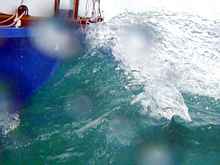
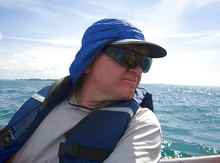 Oaracle’s owner steering from the Ft. Desoto launching ramp to the staring beach of the Everglades Challenge.
Oaracle’s owner steering from the Ft. Desoto launching ramp to the staring beach of the Everglades Challenge.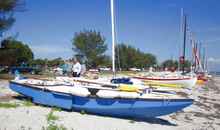 After sailing to the starting line, Oaracle is ready for the start of the Everglades Challenge. Oaracle is a Jim Michalak-designed Frolic2 with a balanced lug rig.
After sailing to the starting line, Oaracle is ready for the start of the Everglades Challenge. Oaracle is a Jim Michalak-designed Frolic2 with a balanced lug rig.